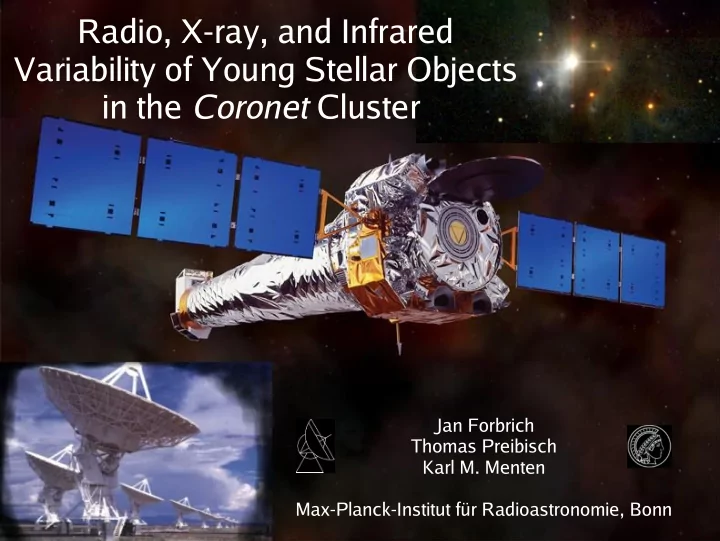

Radio, X-ray, and Infrared Variability of Young Stellar Objects in the Coronet Cluster Jan Forbrich Thomas Preibisch Karl M. Menten Max-Planck-Institut für Radioastronomie, Bonn
Outline ● Introduction – Radio and X-ray Emission from YSOs ● The Coronet Cluster – 1998 multi-epoch VLA observations – 2000-2003 archival ( Chandra & XMM- Newton ) X-ray data, covering >150 ksec in total – Outlook: simultaneous multi-wavelength observations S M A R T S
Radio, X-ray, and NIR emission from protostars ● connection to the different evolutionary stages of protostars is still poorly understood circumstellar material observable e.g. in the NIR magnetospheric bremsstrahlung and/or accretion (e.g. Kastner et al. 2004) e.g. from shock-induced ionisation, easily optically thick ! e.g. gyrosynchrotron, quickly variable, polarized Feigelson & Montmerle (1999) ● X-ray and radio emission probe the innermost regions around YSOs
Multi-wavelength variability of protostars ● variability of protostars has mostly been studied at a single wavelength of the electromagnetic spectrum ● little is known about the relationship of radio, X-ray, and near infrared variability of protostars ● processes are poorly understood ● few simultaneous multi-wavelength observations – Bower (2003): serendipitous discovery (WTTS) – systematic attempts: Feigelson et al. (1994), Guenther et al. (2000) (single TTS), Gagné et al. (2004) (no class 0/I X-ray- and radio-detected)
The Coronet Cluster IRS 4 IRS 6 R CrA IRS 9 IRS 5 IRS 7 T CrA IRS 1 IRS 2 Wilking et al. (1997), K' d = 150 pc
The Coronet at Nisini et al. (2005) NIR wavelengths x x x (IRS 1) IRS1 is the youngest source. IRS2 and IRS5a have about the same age in spite of their different accretion properties. (variable accretion ?)
Radio Emission from the Coronet 1998 VLA 3.6 cm data, (!) integration of 5x2h previous studies by Brown (1987) Suters et al. (1996) Feigelson et al. (1998) Choi & Tatematsu (2004) [IRS 7] CLASS 0 PRESTELLAR ! analyzed 9 epochs of 1998 VLA data spanning nearly four months 450 mu SCUBA: Nutter et al. (2005)
Radio Emission from the Coronet Forbrich, Preibisch, & Menten (2005, submitted) BD? 9 epochs of 1998 VLA data
Radio Emission from the Coronet The circular polarisation of IRS5 is highly variable. Forbrich, Preibisch, & Menten (2005, submitted) see also the discovery paper “Circularly Polarized Radio Emission from an X- Ray Protostar” (Feigelson, Carkner, & Wilking, 1998) 9 epochs of 1998 VLA data
X-rays from the Coronet IRS 2, XMM- Newton IRS 6 IRS 9 R CrA IRS 7W IRS 5 IRS7E IRS 1 Analysis of five archival X-ray datasets: IRS 2 XMM- Newton : 2001, 2x2003 Chandra : 2000, 2003 20 ksec (2000) Chandra ACIS observation (blue: 2.5-8 keV, green: 1.5-2.5 keV, red: 0.2-1.5 keV)
Spectral analysis of the class I protostars IRS 1, 2, and 5 Signs of temporal evolution ? Forbrich, Preibisch, & Menten (2005, submitted) Spectra can be explained by highly absorbed hot plasma emission (several 10MK).
Spectral analysis of the class I protostars IRS 1, 2, and 5 The extinction problem The values for the column densities are all at around half the values derived from NIR colors, as observed towards some other YSOs: L1551IRS5 – Bally et al. (2003) EC95 – Preibisch (2003a) SVS16 – Preibisch (2003b). Maybe the NIR and X-ray emission X-rays from jet shocks close to the protostar ? X-rays scattered towards the observer ? come from detached regions ? huge coronal structures ?
Luminosity curves Forbrich, Preibisch, & Menten (2005, submitted) for IRS 1, 2, 5 IRS5 is again the most variable source. Jun 03 Oct 00 Mar 03 Apr 01
The Herbig Ae star R CrA Forbrich, Preibisch, & Menten (2005, submitted) XMM- Newton XMM- Newton XMM- Newton R CrA has X-ray emission from very hot plasma (100 MK !), but no corona and no strong stellar wind... Takami et al. (2003) find some evidence for the presence of a companion separated by only 0.1” (i.e. only 10-15 AU).
Main Results ● IRS5 shows highly variable nonthermal radio emission with changes in its polarization, also variable X-ray emission ● X-ray spectra of class I protostars IRS 1,2,5 can be ex- plained by absorbed emission of hot plasma (several 10 MK) ● the high absorbing column densities (several 10 22 cm -2 ) are at about half the values derived from NIR colors (the extinc- tion problem ) ● towards the Herbig Ae star R CrA, surprisingly hot plasma emission (100 MK!) was observed, possibly due to a com- panion ● the next step : simultaneous observations in August 2005 with R. Neuhäuser (Jena), B. Posselt (MPE/Jena), and F. Walter (SUNY) S M A R T S
Recommend
More recommend